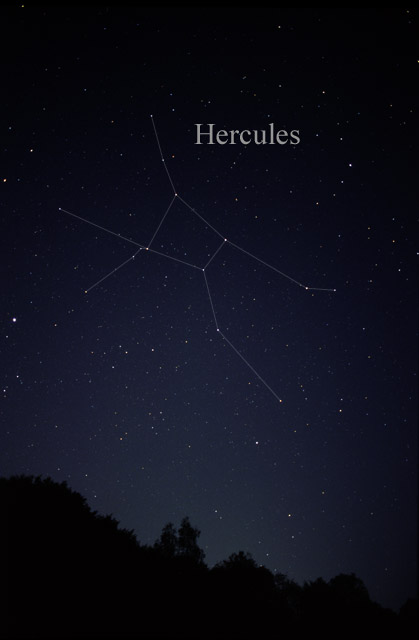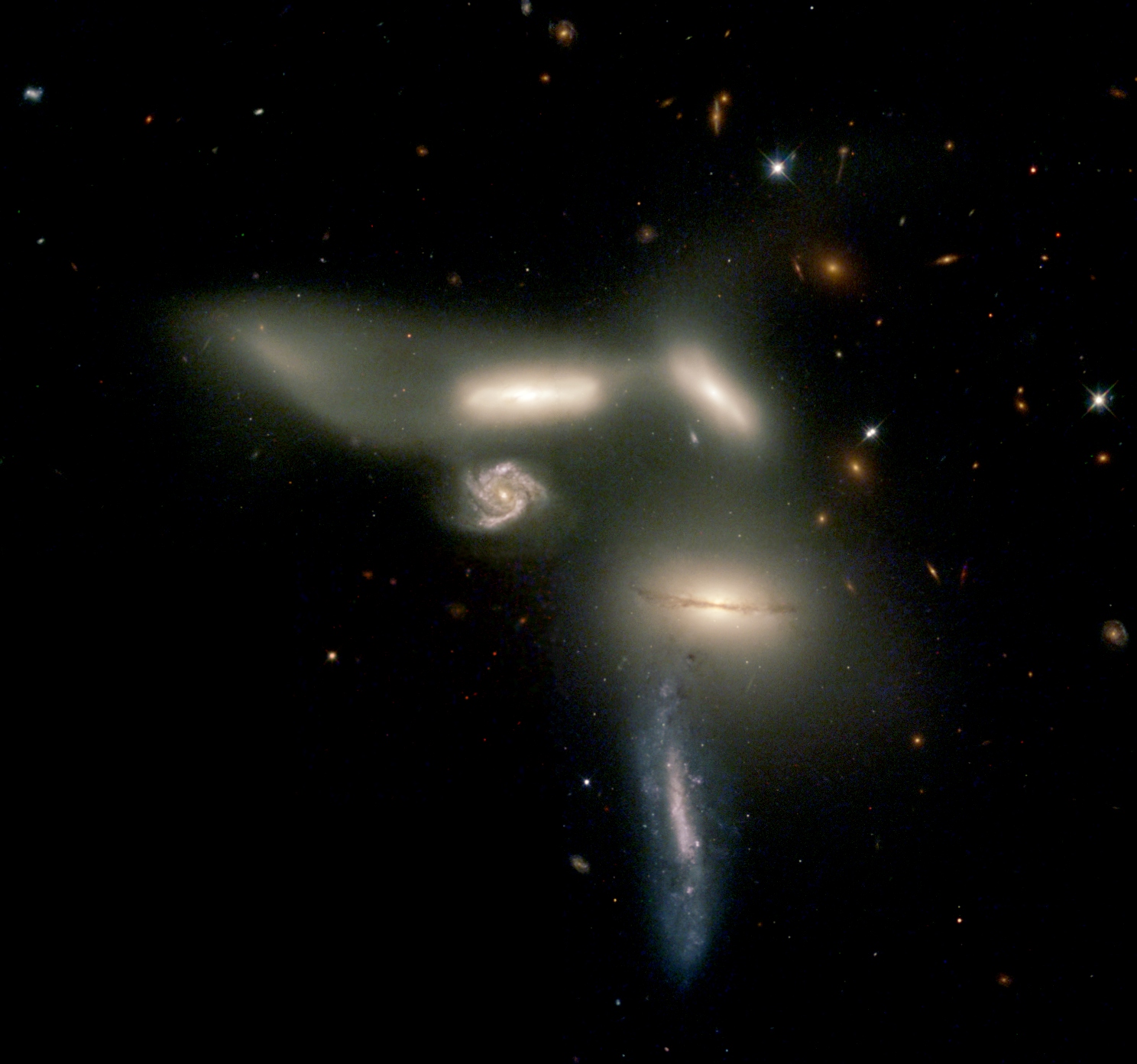|
Zwicky's Triplet
Zwicky's Triplet (Arp 103) is a group of three galaxies visible in the constellation Hercules. The other Zwicky's Triplet IC 3481 at 12h 32m, +11° 24' (2000.0) in Virgo, which is connected to PGC 41646 ("IC 3481A") as the system Arp 175, but probably not connected to IC 3483, is sometimes called Zwicky's Triplet, but this name is more often applied to the system at 16h 49m, +45° 30' (2000.0) in Hercules. See also * Wild's Triplet * Robert's Quartet * Stephan's Quintet * NGC 7331 Group (also known as the Deer Lick Group, about half a degree northeast of Stephan's Quintet) * Seyfert's Sextet * Copeland Septet The Copeland Septet (also Copeland's Septet, Hickson Compact Group 57) is a group of galaxies in the constellation Leo that includes NGC 3748, NGC 3754, NGC 3750, NGC 3751, NGC 3745, NGC 3753 and NGC 3746. The group was discovered by British as ... References Hercules (constellation) Galaxy clusters {{galaxy-cluster-stub ... [...More Info...] [...Related Items...] OR: [Wikipedia] [Google] [Baidu] |
Hercules (constellation)
Hercules is a constellation named after Hercules, the Roman mythological hero adapted from the Greek hero Heracles. Hercules was one of the 48 constellations listed by the second-century astronomer Ptolemy, and it remains one of the 88 modern constellations today. It is the fifth-largest of the modern constellations and is the largest of the 50 which have no stars brighter than apparent magnitude +2.5. Characteristics Hercules is bordered by Draco to the north; Boötes, Corona Borealis, and Serpens Caput to the east; Ophiuchus to the south; Aquila to the southwest; and Sagitta, Vulpecula, and Lyra to the west. Covering 1225.1 square degrees and 2.970% of the night sky, it ranks fifth among the 88 constellations in size. The three-letter abbreviation for the constellation, as adopted by the International Astronomical Union in 1922, is 'Her'. The official constellation boundaries, as set by Eugène Delporte in 1930, are defined by a polygon of 32 segments (''illustra ... [...More Info...] [...Related Items...] OR: [Wikipedia] [Google] [Baidu] |
Group Of Galaxies
A galaxy group or group of galaxies (GrG) is an aggregation of galaxies comprising about 50 or fewer gravitationally bound members, each at least as luminous as the Milky Way (about 1010 times the luminosity of the Sun); collections of galaxies larger than groups that are first-order clustering are called galaxy clusters. The groups and clusters of galaxies can themselves be clustered, into superclusters of galaxies. The Milky Way galaxy is part of a group of galaxies called the Local Group. Characteristics Groups of galaxies are the smallest aggregates of galaxies. They typically contain no more than 50 galaxies in a diameter of 1 to 2 megaparsecs (Mpc).see 1022 m for distance comparisons Their mass is approximately 1013 solar masses. The spread of velocities for the individual galaxies is about 150 km/s. However, this definition should be used as a guide only, as larger and more massive galaxy systems are sometimes classified as galaxy groups. Groups are the most commo ... [...More Info...] [...Related Items...] OR: [Wikipedia] [Google] [Baidu] |
Wild's Triplet
Wild's Triplet is a group of three small, interacting spiral galaxies. The galaxies are visible in the constellation Virgo. The triplet has luminous connecting bridges and is located some 200 million light-years away. The aforementioned bridges are probably formed as a result of gravitational tidal interactions among the galaxies. The triplet is named after the British-born and Australia-based astronomer Paul Wild (1923–2008), who studied the trio in the early 1950s. See also * Zwicky's Triplet * Robert's Quartet * Stephan's Quintet * NGC 7331 Group (also known as the Deer Lick Group, about half a degree northeast of Stephan's Quintet) * Seyfert's Sextet * Copeland Septet The Copeland Septet (also Copeland's Septet, Hickson Compact Group 57) is a group of galaxies in the constellation Leo that includes NGC 3748, NGC 3754, NGC 3750, NGC 3751, NGC 3745, NGC 3753 and NGC 3746. The group was discovered by British as ... References Virgo (constellation) {{galaxy-cl ... [...More Info...] [...Related Items...] OR: [Wikipedia] [Google] [Baidu] |
Robert's Quartet
Robert's Quartet is a compact galaxy group approximately 160 million light-years away in the constellation Phoenix. It is a family of four very different galaxies whose proximity to each other has caused the creation of about 200 star-forming regions and pulled out a stream of gas and dust 100,000 light years long. Its members are NGC 87, NGC 88, NGC 89 and NGC 92, discovered by John Herschel on the 30 September 1834. The quartet is one of the best examples of compact galaxy groups. Because such groups contain four to eight galaxies in a very small region they are excellent laboratories for the study of galactic interactions and their effects, in particular on the formation of stars. The quartet has a total visual magnitude of almost 13. The brightest member of the group is NGC 92, having the blue magnitude of 13.8. On the sky, the four galaxies are all within a circle of radius of 1.6 arcmin, corresponding to about 75,000 light-years. It was named by Halton Arp and Bar ... [...More Info...] [...Related Items...] OR: [Wikipedia] [Google] [Baidu] |
Stephan's Quintet
Stephan's Quintet is a visual grouping of five galaxies of which four form the first compact galaxy group ever discovered. The group, visible in the constellation Pegasus, was discovered by Édouard Stephan in 1877 at the Marseille Observatory. The group is the most studied of all the compact galaxy groups. The brightest member of the visual grouping (and the only non-member of the true group) is NGC 7320, which has extensive H II regions, identified as red blobs, where active star formation is occurring. Four of the five galaxies in Stephan's Quintet form a physical association, a true galaxy group, Hickson Compact Group 92, and will likely merge with each other. Radio observations in the early 1970s revealed a filament of emission between the galaxies in the group. This same region is also detected in the faint glow of ionized atoms seen in the visible part of the spectrum as a green arc. Space telescopes have provided new insight into the nature of the filament, which is no ... [...More Info...] [...Related Items...] OR: [Wikipedia] [Google] [Baidu] |
NGC 7331 Group
NGC 7331 Group is a visual grouping of galaxies in the constellation Pegasus. Spiral galaxy NGC 7331 is a foreground galaxy in the same field as the collection, which is also called the ''Deer Lick Group''. It contains four other members, affectionately referred to as the "fleas": the lenticular or unbarred spirals NGC 7335 and NGC 7336, the barred spiral galaxy NGC 7337 and the elliptical galaxy NGC 7340. These galaxies lie at distances of approximately 332, 365, 348 and 294 million light years, respectively. Although adjacent on the sky, this collection is not a galaxy group, as NGC 7331 itself is not gravitationally associated with the far more distant "fleas"; indeed, even they are separated by far more than the normal distances (~2 Mly) of a galaxy group. See also * Stephan's Quintet, another visual grouping that is not (purely) a galaxy group. Ironically, its non-group member, NGC 7320, might be a member of a true NGC 7331 group, having a similar redshift to that nea ... [...More Info...] [...Related Items...] OR: [Wikipedia] [Google] [Baidu] |
Seyfert's Sextet
Seyfert's Sextet is a group of galaxies about 190 million light-years away in the constellation Serpens. The group appears to contain six members, but one of the galaxies, NGC 6027d, is a background object and another "galaxy," NGC 6027e, is actually a part of the tail from galaxy NGC 6027. The gravitational interaction among these galaxies should continue for hundreds of millions of years. Ultimately, the galaxies will merge to form a single giant elliptical galaxy. Discovery The group was discovered by Carl Keenan Seyfert using photographic plates made at the Barnard Observatory of Vanderbilt University. When these results were first published in 1951, this group was the most compact group ever identified. Members See also * Wild's Triplet * Zwicky's Triplet * Robert's Quartet * Stephan's Quintet Stephan's Quintet is a visual grouping of five galaxies of which four form the first compact galaxy group ever discovered. The group, visible in the constellation ... [...More Info...] [...Related Items...] OR: [Wikipedia] [Google] [Baidu] |
Copeland Septet
The Copeland Septet (also Copeland's Septet, Hickson Compact Group 57) is a group of galaxies in the constellation Leo that includes NGC 3748, NGC 3754, NGC 3750, NGC 3751, NGC 3745, NGC 3753 and NGC 3746. The group was discovered by British astronomer Ralph Copeland in 1874. The location of Copeland's Septet is right ascension / declination (2000.0), about three degrees northwest of third magnitude star 93 Leonis. See also * Wild's Triplet * Zwicky's Triplet * Robert's Quartet * Stephan's Quintet and NGC 7331 Group (also known as the ''Deer Lick Group'' located about half a degree northeast of Stephan's Quintet) * Seyfert's Sextet Seyfert's Sextet is a group of galaxies about 190 million light-years away in the constellation Serpens. The group appears to contain six members, but one of the galaxies, NGC 6027d, is a background object and another "galaxy," NGC 6027e, is ... References Leo (constellation) 57 {{galaxy-cluster-stub ... [...More Info...] [...Related Items...] OR: [Wikipedia] [Google] [Baidu] |
Springer Science & Business Media
Springer Science+Business Media, commonly known as Springer, is a German multinational publishing company of books, e-books and peer-reviewed journals in science, humanities, technical and medical (STM) publishing. Originally founded in 1842 in Berlin, it expanded internationally in the 1960s, and through mergers in the 1990s and a sale to venture capitalists it fused with Wolters Kluwer and eventually became part of Springer Nature in 2015. Springer has major offices in Berlin, Heidelberg, Dordrecht, and New York City. History Julius Springer founded Springer-Verlag in Berlin in 1842 and his son Ferdinand Springer grew it from a small firm of 4 employees into Germany's then second largest academic publisher with 65 staff in 1872.Chronology ". Springer Science+Business Media. In 1964, Springer expanded its business international ... [...More Info...] [...Related Items...] OR: [Wikipedia] [Google] [Baidu] |
Cambridge University Press
Cambridge University Press is the university press of the University of Cambridge. Granted letters patent by Henry VIII of England, King Henry VIII in 1534, it is the oldest university press in the world. It is also the King's Printer. Cambridge University Press is a department of the University of Cambridge and is both an academic and educational publisher. It became part of Cambridge University Press & Assessment, following a merger with Cambridge Assessment in 2021. With a global sales presence, publishing hubs, and offices in more than 40 Country, countries, it publishes over 50,000 titles by authors from over 100 countries. Its publishing includes more than 380 academic journals, monographs, reference works, school and university textbooks, and English language teaching and learning publications. It also publishes Bibles, runs a bookshop in Cambridge, sells through Amazon, and has a conference venues business in Cambridge at the Pitt Building and the Sir Geoffrey Cass Spo ... [...More Info...] [...Related Items...] OR: [Wikipedia] [Google] [Baidu] |






